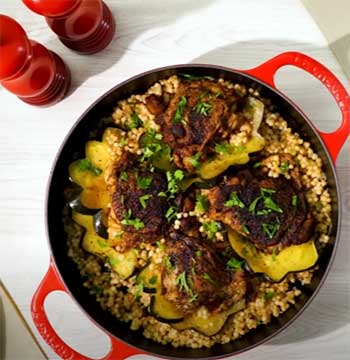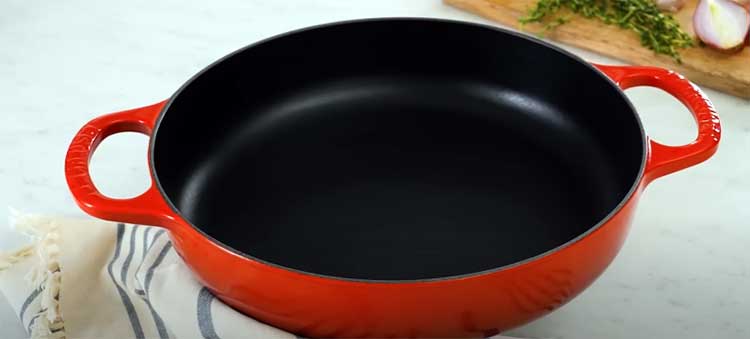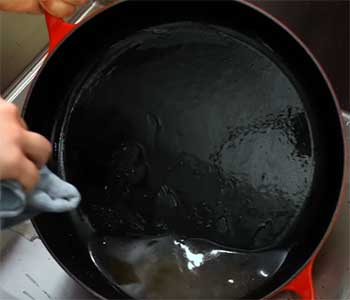Let me tell you something: if you’re serious about cooking, the Le Creuset sauté pan is a game-changer. It’s not just a pan; it’s a kitchen companion that elevates every dish you make.
With its stunning design, unbeatable durability, and performance that makes you feel like a pro chef, this pan is worth every penny. Whether you’re sautéing veggies or braising meat, it delivers results that’ll have you grinning at the stove.
Trust me, you need this pan in your life—it’s an investment in flavor, style, and culinary joy.
My Journey With The Le Creuset Sauté Pan

Picture this: I’m standing in my kitchen, unboxing my brand-new Le Creuset sauté pan, its vibrant Cerise red enamel gleaming under the light.
It’s heavy—solid, like it means business—but the moment I set it on my stovetop, I knew I was in for something special.
I’ve been cooking with it for months now, and let me tell you, it’s been a revelation.
From searing chicken thighs to simmering a rich mushroom risotto, this pan has become my go-to for almost every meal.
My first experience was a simple sauté of garlic and spinach. The pan heated up slowly but evenly, and the aroma of garlic sizzling in olive oil filled my kitchen. The spinach wilted perfectly, no hot spots, no sticking—just a smooth, effortless cooking process.
I was hooked. Next, I tried braising short ribs, and the way the pan retained heat made the meat melt-in-your-mouth tender. The wide, shallow design gave me plenty of room to brown the ribs, and the tight-fitting lid locked in all that flavor.
What struck me most was the pan’s versatility. I’ve used it on my gas stove, popped it in the oven for a baked pasta dish, and even served straight from it at a dinner party. The enamel finish not only looks gorgeous but also makes cleanup a breeze—more on that later.
I’ve cooked for one and for a crowd, and this pan handles it all with grace. It’s like having a sous-chef who never complains. Sure, it’s an investment, but every time I use it, I’m reminded why I fell in love with cooking in the first place.
What Makes The Le Creuset Sauté Pan Special?
Let’s talk about what sets this pan apart. The Le Creuset sauté pan is crafted from enameled cast iron, a material that’s been a hallmark of the brand since 1925. The cast iron core gives it incredible heat retention, so once it’s hot, it stays hot, delivering consistent results.
The enamel coating adds a non-reactive surface, meaning you can cook acidic foods like tomatoes or lemon-based sauces without worrying about metallic flavors.
Plus, it’s stunning—available in colors like Flame, Marseille, and my personal favorite, Cerise, it’s as much a centerpiece as it is a cooking tool.
The design is thoughtful, too. The pan’s wide, shallow shape is perfect for sautéing, with enough surface area to brown ingredients without crowding. The sloped sides make it easy to toss veggies or slide a spatula under a piece of fish.
It comes with a helper handle, which is a lifesaver when you’re lifting a full pan, and the lid fits snugly to trap moisture and flavor. It’s oven-safe up to 500°F, so you can start on the stovetop and finish in the oven without a hitch.
This pan isn’t just functional; it’s built to inspire confidence in the kitchen.
The Pros of The Le Creuset Sauté Pan

- Unmatched Durability
This pan is a tank. The cast iron construction means it can handle years of heavy use without warping or cracking. I’ve dropped mine (oops) and cooked at high heats, and it still looks as good as the day I bought it.
The enamel coating resists chipping and scratching, so you don’t have to baby it. I’ve used metal utensils without a scratch, and it’s still pristine. With proper care, this pan could outlast me, and I love the idea of passing it down to my kids someday.
- Even Heat Distribution
If you’ve ever dealt with hot spots that burn one part of your dish while leaving another undercooked, you’ll appreciate this pan. The cast iron heats slowly but evenly, so every inch of the cooking surface is consistent.
I’ve seared steaks to perfection, with a golden crust across the entire surface, and sautéed delicate veggies without scorching. It’s like the pan knows exactly what you need, making it easier to nail those tricky recipes.
- Versatility for Every Recipe
This pan is a jack-of-all-trades. I’ve used it for everything from frying eggs to braising pork, and it excels every time. The wide surface is great for browning, while the depth and lid make it ideal for one-pot meals like stews or risottos.
You can take it from stovetop to oven, and it works on all cooktops, including induction. I even baked a cornbread in it once, and the crust was perfectly crispy. Whatever you’re cooking, this pan’s got your back.
- Aesthetic Appeal
Let’s be honest: this pan is gorgeous. The vibrant enamel finish turns heads, and it’s not just for show. I’ve served dishes straight from the pan at dinner parties, and guests always comment on how stunning it looks.
It’s like a piece of art you can cook with. The variety of colors means you can pick one that matches your kitchen vibe, and it’s a joy to display on your stove or table.
- Non-Reactive Surface
The enamel coating isn’t just pretty; it’s practical. You can cook acidic foods like tomato sauce or citrus-marinated chicken without worrying about the pan reacting or altering the flavor.
I’ve simmered a marinara sauce for hours, and the taste was pure, with no metallic aftertaste. This feature gives you freedom to experiment with bold flavors without hesitation.
The Cons of The Le Creuset Sauté Pan
- Hefty Price Tag

Let’s not sugarcoat it: this pan is expensive.
Prices for a Le Creuset sauté pan typically start around $200 and can climb higher depending on size.
For some, that’s a tough pill to swallow, especially if you’re used to cheaper cookware.
I felt the sting when I bought mine, but after using it, I can say it’s worth every cent.
If your budget is tight, you might need to save up or wait for a sale, but the quality justifies the cost over time.
- Weighty Design
This pan is heavy—around 7 to 9 pounds depending on the size. That weight is part of what makes it so durable and heat-retaining, but it can be a challenge if you have limited strength or mobility.
I’ve gotten used to it, but the first few times I lifted it full of food, I was grateful for the helper handle. If you’re not comfortable with heavy cookware, this might not be the best fit.
- Slow to Heat Up
The cast iron takes its time to get hot, which can test your patience if you’re in a rush. I’ve learned to preheat it on medium for a few minutes to get it ready, but it’s not as quick as a lightweight aluminum pan.
Once it’s hot, though, it stays that way, so it’s a trade-off. If you’re all about speed, this might feel like a drawback.
- Not Truly Non-Stick
While the enamel coating is smooth and easier to clean than raw cast iron, it’s not non-stick in the way a Teflon-coated pan is. I’ve had food stick occasionally, especially if I don’t use enough oil or if the heat’s too high.
It’s not a dealbreaker, but it requires a bit of technique to get the best results. If you’re used to non-stick pans, you’ll need to adjust your cooking style slightly.
Maintenance Tips For Your Le Creuset Sauté Pan
- Cleaning the Right Way
Keeping your Le Creuset sauté pan in top shape is easier than you might think. After cooking, let it cool completely before washing—dunking a hot pan in cold water can cause thermal shock and damage the enamel.
I usually wash mine by hand with warm soapy water and a soft sponge. Most food slides right off, but for stubborn bits, I soak it for 10-15 minutes. Le Creuset says it’s dishwasher-safe, but I avoid that to preserve the enamel’s shine.
Harsh detergents can dull the finish over time, and I want mine to stay vibrant.
- Protecting the Enamel
The enamel coating is tough, but it’s not invincible. Avoid using abrasive scrubbers like steel wool, as they can scratch the surface. I stick to nylon brushes or soft sponges, and my pan still looks brand new.
Also, don’t stack heavy items on top of it in storage—chips are rare but possible. I store mine with a soft cloth or pan protector between it and other cookware to keep it pristine.
- Seasoning the Interior
While the enamel doesn’t require seasoning like raw cast iron, the matte black interior can develop a natural patina over time, which helps with food release.
To encourage this, I occasionally rub a thin layer of vegetable oil on the cooking surface after cleaning and drying. It’s not mandatory, but I’ve found it reduces sticking, especially for eggs or delicate fish.
Just make sure the pan is completely dry to prevent rust.
- Avoiding Thermal Shock
Cast iron and enamel don’t love sudden temperature changes. I never put a hot pan under cold water or place a cold pan on a screaming-hot burner.
Instead, I let it cool naturally and preheat it gradually. This habit has kept my pan in perfect condition, and I’ve avoided any cracks or damage. Patience is key with this pan—it’s built to last, but you’ve got to treat it with a little respect.
- Storing Properly
To keep your pan looking as good as it performs, store it in a dry place. Moisture is the enemy of cast iron, even with the enamel coating. I keep mine in a cabinet with good airflow, and I never stack it wet.
If you’re tight on space, consider hanging it on a pot rack—it’s pretty enough to show off, and it saves cabinet space. Just make sure it’s secure, given its weight.
Comparing The Le Creuset Sauté Pan To Other Brands
- Staub Sauté Pan
Staub, another French heavyweight, is often compared to Le Creuset, and for good reason. Their sauté pans are also made of enameled cast iron, offering similar heat retention and durability.
I tried a Staub pan at a friend’s house, and it performed beautifully, especially for braising. The main difference is the interior—Staub’s is textured, which some say enhances browning.
However, I found Le Creuset’s smoother enamel easier to clean. Staub pans are slightly cheaper, but the price gap isn’t huge. If you love dark, matte aesthetics, Staub might edge out, but I prefer Le Creuset’s vibrant colors and polished finish.
- Lodge Cast Iron
Lodge is the budget-friendly king of cast iron, and their sauté pans are a fraction of Le Creuset’s price. I own a Lodge skillet, and while it’s great for searing, it lacks the enamel coating, so you have to season it regularly to prevent rust.
It’s also heavier than Le Creuset, which surprised me. Lodge is fantastic for no-frills cooking, but it doesn’t have the non-reactive surface or aesthetic appeal of Le Creuset.
If you’re on a tight budget, Lodge is a solid choice, but it requires more maintenance and isn’t as versatile for acidic dishes.
- All-Clad Stainless Steel
All-Clad’s stainless steel sauté pans are a favorite among pros for their quick heating and lightweight design. I borrowed one for a week, and it was a dream for fast-paced cooking like stir-fries.
However, it doesn’t retain heat as well as Le Creuset, so it’s less ideal for slow braises. All-Clad is also pricy, sometimes matching Le Creuset’s cost, but it lacks the visual charm and oven versatility.
If you prioritize speed and don’t need the cast iron heft, All-Clad is worth considering, but I missed Le Creuset’s even cooking and style.
- Calphalon Non-Stick
Calphalon’s non-stick sauté pans are affordable and great for beginners who want food to slide out effortlessly. I used one years ago, and it was perfect for eggs and pancakes. But the non-stick coating wears out over time, unlike Le Creuset’s enamel, which is built to last.
Calphalon is lighter and easier to handle, but it can’t handle high oven temperatures or metal utensils. If non-stick is your priority and you’re not ready to invest, Calphalon is fine, but it won’t match Le Creuset’s durability or versatility.
- Cuisinart Enameled Cast Iron
Cuisinart offers a more affordable enameled cast iron sauté pan, and I tested one at a cooking class. It’s decent for the price, with good heat distribution and a non-reactive surface. However, the enamel felt thinner, and it chipped after a few months of heavy use.
Le Creuset’s build quality is noticeably superior, and the lifetime warranty gives me peace of mind. Cuisinart is a good entry point if you’re hesitant about the cost, but it doesn’t have the same longevity or premium feel.
Also Read: Should You Get Mauviel Cookware?
Frequently Asked Questions (FAQ)
I’m biased toward my Le Creuset sauté pan, and for good reason. Its combination of durability, even heat distribution, and versatility makes it a standout. The enameled cast iron handles everything from searing to braising, and the aesthetic appeal is unmatched. While brands like Staub and All-Clad offer strong competition, Le Creuset’s lifetime warranty and timeless design give it the edge for me. If you’re looking for a pan that’ll last decades and elevate your cooking, this is the one to beat.
The biggest drawbacks are the price and weight. A Le Creuset sauté pan can cost upwards of $200, which isn’t pocket change. It’s also heavy, around 7-9 pounds, which can be tough to maneuver if you’re not used to cast iron. The enamel isn’t truly non-stick, so you might need extra oil to prevent sticking. Finally, it heats up slowly, which can be a hassle if you’re in a rush. Still, these are small trade-offs for the quality you get.
Absolutely, it’s oven-safe up to 500°F, including the lid. I’ve used mine for everything from roasting veggies to finishing a braise in the oven, and it performs flawlessly. Just make sure to use oven mitts—the handles get hot! The ability to go from stovetop to oven makes it incredibly versatile, especially for recipes that need a seamless transition.
If food is sticking, it’s usually due to insufficient oil, improper preheating, or high heat. The enamel interior isn’t non-stick like Teflon, so you need a thin layer of oil or butter to create a barrier. I’ve found that preheating the pan on medium for 3-5 minutes helps, as does letting proteins like meat sit until they release naturally. If sticking persists, try rubbing a light layer of oil on the interior after cleaning to build a slight patina.
Why The Le Creuset Sauté Pan Is A Must-Have?
You need this pan in your kitchen. The Le Creuset sauté pan isn’t just cookware; it’s a partner that makes every meal better. Its durability, versatility, and stunning design transform cooking into a joy, whether you’re whipping up a quick weeknight dinner or hosting a feast.
Yes, it’s pricey and heavy, but the results—perfectly cooked dishes and a pan that lasts a lifetime—are worth it. Grab one, and you’ll wonder how you ever cooked without it. Your kitchen deserves this masterpiece.
